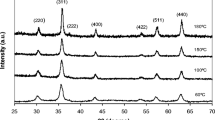Abstract
The growth process of hydrophilic iron oxide nanoparticles synthesized via the non-aqueous sol–gel method using TEG as high-boiling solvent has been characterized. A model of the growth process is presented, based on a combination of analytical methods, especially XRD, SAXS and TGA. In contrast to previously studied particles synthesized in benzyl alcohol, which grow via nucleation, particles synthesized in TEG grow via a sol–gel-like process. In a first step, an amorphous network is formed, and subsequently, during the compaction of the network, crystalline particles are obtained. The influence of the structural properties on the magnetic behavior was identified by combining various spectroscopic methods.
Graphical Abstract












Similar content being viewed by others
References
Babiuch K, Wyrwa R, Wagner K, Seemann T, Hoeppener S, Becer CR, Linke R, Gottschaldt M, Weisser J, Schnabelrauch M, Schubert US (2011) Functionalized, biocompatible coating for superparamagnetic nanoparticles by controlled polymerization of a thioglycosidic monomer. Biomacromolecules 12(3):681–691. doi:10.1021/bm101325w
Camponeschi E, Walker J, Garmestani H, Tannenbaum R (2008) Surfactant effects on the particle size and formation of iron oxides via a sol-gel process. In: ACS symposium series, vol 996. pp 124–138. doi:10.1021/bk-2008-0996.ch010
Cerff M, Scholz A, Franzreb M, Batalha I, Roque A, Posten C (2013) In situ magnetic separation of antibody fragments from Escherichia coli in complex media. BMC Biotechnol 13(1):1–16. doi:10.1186/1472-6750-13-44
Cha J, Lee JS, Yoon SJ, Kim YK, Lee JK (2013) Solid-state phase transformation mechanism for formation of magnetic multi-granule nanoclusters. RSC Adv 3(11):3631–3637. doi:10.1039/C3RA21639J
Cheema T, Lichtner A, Weichert C, Böl M, Garnweitner G (2012) Fabrication of transparent polymer-matrix nanocomposites with enhanced mechanical properties from chemically modified ZrO2 nanoparticles. J Mater Sci 47(6):2665–2674. doi:10.1007/s10853-011-6092-5
Cui H, Liu Y, Ren W (2013) Structure switch between \(\alpha \text{-Fe}_{2}\text{O}_{3}\), \(\gamma \text{-Fe}_{2}\text{O}_{3}\) and \(\text{Fe}_{3}\text{O}_{4}\) during the large scale and low temperature sol-gel synthesis of nearly monodispersed iron oxide nanoparticles. Adv Powder Technol 24(1):93–97. doi:10.1016/j.apt.2012.03.001
Espinosa D, Carlsson LB, Neto AMF, Alves S (2013) Influence of nanoparticle size on the nonlinear optical properties of magnetite ferrofluids. Phys Rev E 88:032,302. doi:10.1103/PhysRevE.88.032302
Franzreb M, Siemann-Herzberg M, Hobley T, Thomas OT (2006) Protein purification using magnetic adsorbent particles. Appl Microbiol Biotechnol 70(5):505–516. doi:10.1007/s00253-006-0344-3
Grabs IM, Bradtmöller C, Menzel D, Garnweitner G (2012) Formation mechanisms of iron oxide nanoparticles in different nonaqueous media. Cryst Growth Des 12(3):1469–1475. doi:10.1021/cg201563h
Grosvenor AP, Kobe BA, McIntyre NS (2004) Studies of the oxidation of iron by air after being exposed to water vapour using angle-resolved X-ray photoelectron spectroscopy and QUASES. Surf Interface Anal 36(13):1637–1641. doi:10.1002/sia.1992
Gupta AK, Gupta M (2005) Synthesis and surface engineering of iron oxide nanoparticles for biomedical applications. Biomaterials 26(18):3995–4021. doi:10.1016/j.biomaterials.2004.10.012
Gupta RP, Sen SK (1974) Calculation of multiplet structure of core p-vacancy levels. Phys Rev B 10(1):71–77. doi:10.1103/PhysRevB.10.71 PRB
Halliwell B, Gutteridge JMC (1990) Role of free radicals and catalytic metal ions in human disease: an overview, vol 186. Academic Press, London
Hansen MF, Koch CB, Mørup S (2000) Magnetic dynamics of weakly and strongly interacting hematite nanoparticles. Phys Rev B 62:1124–1135. doi:10.1103/PhysRevB.62.1124
Josephson L (2006) Magnetic nanoparticles for MR imaging, chap. 8. Springer, Berlin
Kraken M, Masthoff IC, Borchers A, Litterst FJ, Garnweitner G (2014) Formation of magnetic nanoparticles studied during the initial synthesis stage. Hyperfine Interact 224(1–3):57–63. doi:10.1007/s10751-013-0767-z
Krishnan S, Diagaradjane P, Cho SH (2010) Nanoparticle-mediated thermal therapy: evolving strategies for prostate cancer therapy. Int J Hyperth 26(8):775–789. doi:10.3109/02656736.2010.485593
Masthoff IC, David F, Wittmann C, Garnweitner G (2013) Functionalization of magnetic nanoparticles with high-binding capacity for affinity separation of therapeutic proteins. J Nanopart Res 16(1):1–10. doi:10.1007/s11051-013-2164-6
Masthoff IC, Kraken M, Mauch D, Menzel D, Munevar J, Baggio Saitovitch E, Litterst FJ, Garnweitner G (2014) Study of the growth process of magnetic nanoparticles obtained via the non-aqueous sol-gel method. J Mater Sci 49(14):4705–4714. doi:10.1007/s10853-014-8160-0
McIntyre NS, Zetaruk DG (1977) X-ray photoelectron spectroscopic studies of iron oxides. Anal Chem 49(11):1521–1529. doi:10.1021/ac50019a016
Minati L, Micheli V, Rossi B, Migliaresi C, Dalbosco L, Bao G, Hou S, Speranza G (2011) Application of factor analysis to XPS valence band of superparamagnetic iron oxide nanoparticles. Appl Surf Sci 257(24):10,863–10,868. doi:10.1016/j.apsusc.2011.07.123
Niederberger M, Garnweitner G (2006) Organic reaction pathways in the nonaqueous synthesis of metal oxide nanoparticles. Chem A Eur J 12(28):7282–7302. doi:10.1002/chem.200600313
Pinna N, Garnweitner G, Antonietti M, Niederberger M (2005) A general nonaqueous route to binary metal oxide nanocrystals involving a C–C bond cleavage. J Am Chem Soc 127(15):5608–5612. doi:10.1021/ja042323r
Reena MAP, Anantharaman MR (2013) Superparamagnetic iron oxide nanoparticles based aqueous ferrofluids for biomedical applications. In: Orsucci FF, Sala N (ed) Ferrofluids. Nova Science Publishers, Hauppauge
Walker JD, Tannenbaum R (2006) Characterization of the sol-gel formation of iron(III) oxide/hydroxide nanonetworks from weak base molecules. Chem Mater 18(20):4793–4801. doi:10.1021/cm0609101
Wang YXJ (2011) Superparamagnetic iron oxide based MRI contrast agents: current status of clinical application. Quant Imaging Med Surg 1(1):35–40. doi:10.3978/j.issn.2223-4292.2011.08.03
Zhang XQ, Gong SW, Zhang Y, Yang T, Wang CY, Gu N (2010) Prussian blue modified iron oxide magnetic nanoparticles and their high peroxidase-like activity. J Mater Chem 20:5110–5116. doi:10.1039/C0JM00174K
Acknowledgments
The authors thank Prof. G. Goya and G. Antorrena Pardo and A. Ibarra Galián, University of Zaragoza, Spain, for the XPS and TEM analysis. Helpful discussions with Prof. E. Baggio Saitovitch and Dr. J. Munevar are acknowledged. Financial support from SynFoBiA (Center of Pharmaceutical Engineering, PVZ) is gratefully acknowledged. Part of this work has been supported by PROBRAL (DAAD-CAPES).
Author information
Authors and Affiliations
Corresponding author
Ethics declarations
Conflict of interest
The authors declare that they have no conflict of interest.
Electronic supplementary material
Below is the link to the electronic supplementary material.
Rights and permissions
About this article
Cite this article
Masthoff, IC., Kraken, M., Menzel, D. et al. Study of the growth of hydrophilic iron oxide nanoparticles obtained via the non-aqueous sol–gel method. J Sol-Gel Sci Technol 77, 553–564 (2016). https://doi.org/10.1007/s10971-015-3883-1
Received:
Accepted:
Published:
Issue Date:
DOI: https://doi.org/10.1007/s10971-015-3883-1



